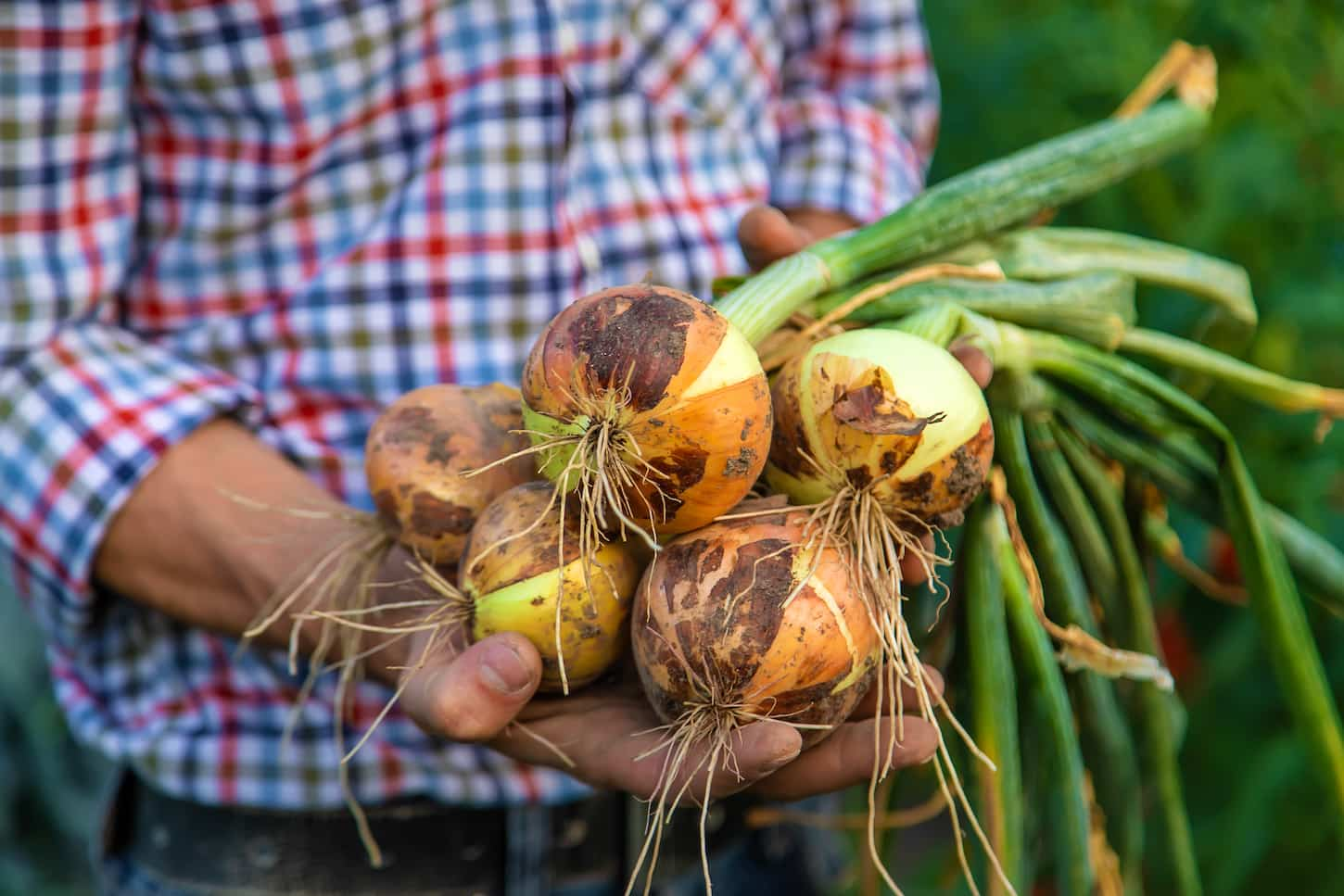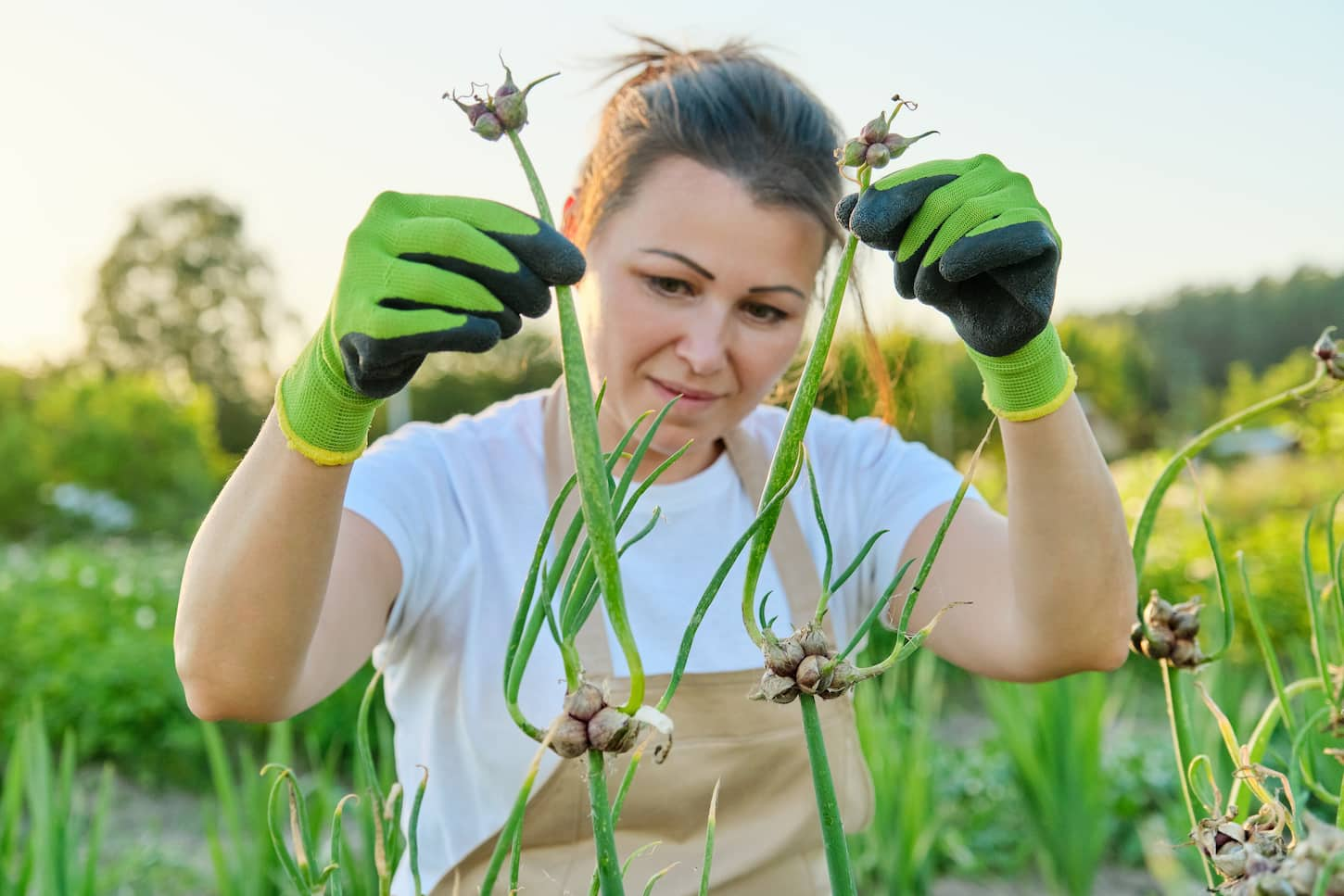Onions are one of the most important and most used ingredients in every kitchen. The main dish is just not complete without onions! Have you ever wondered how this vegetable is grown? Do they grow above ground, just like every other vegetable, or underground?
Onions are versatile because they can grow underground, in water, and above ground as they are a modified stem vegetable called a tunicate bulb. Different varieties do best in different locations.
If you’re planning to have some onions in the home garden and would like to know more about it, then this article is just the right thing for you, so let’s keep going.

Is Onion an Underground Vegetable?
Onions produce edible parts from both above and below the ground. They sit above ground while the very bottom is just below the line of the soil. The part of the onion that is normally consumed is not the base of the plant, but in fact what is called the ‘modified stem.’
There are three methods in which you can plant onions – either through seeds, transplants, or sets (tiny bulblets).
Are Onions Supposed to Grow Above Ground?
Sprouting out of the ground is a natural occurrence for onions because they are meant to grow into a new plant, though some varieties of onions’ edible portions always grow above the ground.
Onion bulbs sit with their roots halfway into the ground, and they are also considered to be an underground plant since they grow out of the ground.
There are a lot of varieties of onions, yellow onions, brown, red, purple, white, leeks, chives, shallots, and many more! These varieties are divided into two – they are known bunching onions and bulbing onions.
Bunching onions, also known as green onions (scallions) belong to the species of Allium Fistulosum. This variety of onions doesn’t form large bulbs and they only grow as stems above ground.
This variety is also sometimes used as an ornamental plant. Bulbing onions grow large, modified stems that turn into bulbs (onion bulbs). However, there are also some instances where a bulbing onion also produces green onions early in its season, so it’s hard to distinguish one from another.

Why Are My Onions Growing out of the Ground?
When onions grow, they push out of the ground, their stems sprout, and they grow into bulbs. As they reach full maturity the outer layer of the bulb begins to turn yellow, fall over, and become papery.
Onions grow after they have been dormant for a long period of time, and with the right temperature, new growth will begin. The onion bulbs will then grow white roots and new stems will sprout.
After sprouting, the onion bulbs will then quickly rot. Rotten bulbs can be replanted because they are still capable of growing into new and fresh onions.
Do Onions Grow up out of The Soil or Down into the Soil?
As onion plants start to absorb nutrients, the first shoots will appear, and then naturally the shoots will grow upward, reaching for the sun. Once the shoots break out of the soil, the seedlings will then change focus and direct all their energy to developing leaves (stems).
Once 8 to 12 leaves develop, the plant will then stop sending new leaves and will now focus all its energy and resources on the bulbing process. The onions will now then begin to push the soil away and grow out of the ground.
Through natural occurrence, onions will first start germinating in the vegetative phase after they are planted. In this phase, the seeds will grow roots after planting and then absorb moisture and nutrients from the soil which will then drive plant growth.
Onions only have three distinct phases of growth: the vegetative phase, bulbing phase, and the blooming (bolting) phase. If triggered by environmental factors, they can switch from one phase to another.
The onions will then approach the maturity phase and the bulb will increase in size. Once the resources from the leaves are gone the tops will dry out and fall down. Then the onions are ready to harvest.
Some gardeners wait until the blooming (bolting phase) that usually occurs in the second growing season. If the seeds aren’t harvested during this phase, they will fall back to the ground and start another cycle of life the next spring.
Did you know? Fun onion facts
- Onions are actually from the family of Allium (Amaryllidaceous). The Amaryllidaceous are ornamental plants that include daffodils, lilies, sternbergia, snowdrops, amaryllis, clivia, and snowflakes.
- Vegetables such as chives, leeks, garlic, and onions belong to this family.
- According to Biology Libretexts: Onion bulbs are stems and not roots. The stems grow into bulbous form. So, the onions we use are actually a stem.
- Onions offer a range of health benefits. They can help boost the immune system, control cholesterol levels, and also help in regulating blood sugar levels.
Science keeps changing its mind on the exact benefits of onions, while also finding new awesome benefits. So we won’t focus on these beyond the generally universal fact that onions make food taste great!

Key Takeaways and Next Steps
Onions do indeed grow both above the ground and underground. How cool is that? Quite a few people believe that they grow underground and are root vegetables. They are actually a type of modified stem vegetable called a tunicate bulb. They are considered neither a root nor a stem vegetable!
In any case, gardening is amazing. You learn so many cool facts, and hopefully, you even gain some wisdom (like not putting tomatoes in a fruit salad).
For some great information about gardening, please read our article answering the question: Can Carrots Grow on Trees? It’s an actual question, and there are some cool answers that you wouldn’t have considered if you’d just brushed it aside with a quick “of course not!” kind of answer. So go give that a read next.
Resources
Learning from your own experience is essential, but learning from others is also intelligent. These are the sources used in this article and our research to be more informed as homesteaders.
- “Allium Fistulosum – Plant Finder.” Missouri Botanical Garden – Gardening Help, www.missouribotanicalgarden.org/PlantFinder/PlantFinderDetails.aspx?taxonid=256068. Accessed 20 Jan. 2022.
- “Onions.” Almanac.Com, www.almanac.com:443/plant/onions. Accessed 20 Jan. 2022.
- Libretexts. “30.2D: Stem Modifications.” Biology LibreTexts, 6 Mar. 2021, bio.libretexts.org/Bookshelves/Introductory_and_General_Biology/Book%3A_General_Biology_(Boundless)/30%3A_Plant_Form_and_Physiology/30.2%3A_Stems/30.2D%3A__Stem_Modifications.